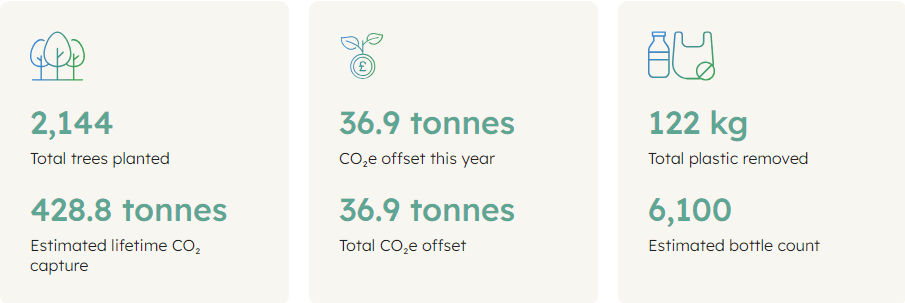Our Enhanced Commitment to a Sustainable Future: The Carbon Footprint Challenge

At Trifibre, we’re dedicated to mitigating our environmental impacts and working towards sustainable production. As a manufacturer of rotational moulded products and protective packaging including casing solutions that necessitate the use various materials including foam, plastics and wood we realise our responsibility to work hard to minimise our impact on the environment. Our strategic approach not only includes reducing our carbon footprint but also embraces decarbonisation and eco-design as avenues for fostering more profitable, eco-friendly businesses.
In our journey towards sustainability, we are actively enhancing our operations by adopting measures such as the ISO 14001 environmental policy and investing in our facilities and worldwide environmental projects, all aimed at significantly lowering our carbon footprint. This commitment is further solidified through our efforts in calculating and setting targets on our direct and indirect emissions, ensuring we take steps towards a sustainable future.
One Tree Planted for Every Online Order
In alignment with our dedication to reducing our carbon footprint, we have inaugurated the Tree Planting Initiative with Switch2Zero, a cornerstone of our environmental commitment. The importance of this endeavour cannot be overstated, as trees play a crucial role in absorbing carbon dioxide from the air and storing it in wood, plant matter, and soil, thus significantly mitigating the effects of carbon emissions.
Earth Positive Workforce
Trifibre have increased our commitment to sustainability further by engaging in a subscription for a pre-built plan that offsets each employee’s emissions to create an earth-positive workforce and get shareable assets to engage our team and customers. The scheme, again utilising Switch2Zero helps to fund offset projects, the planting of tress and removal of plastic waste.
ISO 14001 Environmental Policy Adoption
Embracing the ISO 14001 environmental policy signifies our unwavering commitment to enhancing environmental performance and sustainability in every facet of our operations. This international standard provides a robust framework for managing environmental responsibilities efficiently, focusing on significant areas such as air pollution, water and soil management, and climate change mitigation. It’s designed to foster continuous improvement, ensuring our practices not only comply with current regulations but also anticipate future environmental standards. By integrating ISO 14001 into our existing management systems, we’re able to streamline our processes, leading to better resource utilisation, waste reduction, and overall environmental impact minimisation.
The adoption of ISO 14001 has catalysed a transformative shift within our organisation, heightening leadership involvement and employee engagement in our environmental initiatives. This heightened focus on strategic environmental management has bolstered our reputation setting us apart as industry leaders committed to sustainable practices. Furthermore, this standard has opened avenues for financial and competitive advantages by highlighting areas for efficiency improvements and cost reductions, directly contributing to our bottom line while reducing our ecological footprint.
Our journey with ISO 14001 extends beyond compliance and operational efficiency; it embodies our dedication to environmental stewardship. Through rigorous identification and management of environmental risks, we’ve not only mitigated potential legal and financial liabilities but have also enhanced our market opportunities by aligning with the sustainability values of our clients.
Conclusion
Throughout this article, we have journeyed through Trifibre’s steadfast dedication to sustainability and environmental stewardship. From our ambitious net-zero emissions target to the initiation of innovative projects such as the Tree Planting Initiative, Earth Positive Workforce, and the adoption of ISO 14001. We have showcased how integrating sustainability into every aspect of our business not only aids in reducing our carbon footprint but also enhances our operational efficiency and market competitiveness. These endeavours underscore our commitment to a greener future, highlighting the significant strides we are making towards mitigating our environmental impact while fostering economic viability.
As we move forward, it is evident that our sustainability journey is a collective endeavour, bolstered by partnerships, employee engagement, and a culture of continuous improvement. The implications of our actions are far-reaching, offering a blueprint for responsible business practices that harmonise with our planet’s ecological boundaries. By sharing our experiences and insights, we aim to inspire others to embark on their sustainability journey, reinforcing the importance of collaboration and innovation in addressing the environmental challenges of our time. Therefore, our narrative not only reflects our current achievements but also heralds our unwavering ambition to pioneer a sustainable future for all.
FAQs
How can sustainability help to minimise our carbon footprint?
To minimise your carbon footprint, you can adopt clean energy sources, alter your travel habits, and decrease overall consumption by engaging in recycling and reusing materials as much as possible.
What impact does our carbon footprint have on the future?
The ongoing emission of greenhouse gases is expected to result in more climate change, characterized by a warmer atmosphere, higher and more acidic ocean temperatures, rising sea levels, and significant shifts in precipitation patterns.
What is considered a sustainable carbon footprint level?
On a global scale, the average carbon footprint is about 4 tons. However, to significantly reduce the risk of a 2℃ increase in global temperatures, the average global carbon footprint per year should be less than 2 tons by 2050. Reducing individual carbon footprints from 16 tons to 2 tons is a process that will take time and concerted effort.
What actions can you take to lower your carbon footprint?
To start reducing your carbon footprint, consider these practical steps: avoid buying water in plastic bottles, opt for walking or biking for short trips, always turn off lights and unplug devices when not in use, and maintain your vehicle with properly inflated tires and regular tune-ups.